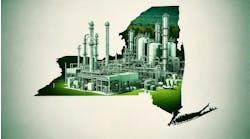Running the pumps can account for more than 20% of the total electricity consumed in a plant. However, it’s not simply the pump and its drive that consumes all the energy, but the pumping system as a whole. [pullquote]Pumping system efficiency is defined as the ratio of the actual work delivered by the pump in moving the fluid to the energy supplied to the motor drive. Only the required head and flow rates are considered in calculating delivered energy and system efficiency. Unnecessary head losses are deducted from the pump head, and unnecessary bypass or recirculation flow is deducted from the pump flow rate. Efficiency tests help engineers identify inefficient systems, determine energy-efficiency improvement measures, and estimate potential energy savings.In a typical pumping system energy use is broken down as follows: piping pressure drop — 29%; throttling process — 25%; pump operation — 20%; actual delivered energy — 18%; and motor operation — 8%. From the breakdown, only 18% of the supplied energy goes for valuable work, making it the pumping system efficiency. The remaining 82% is wasted energy and available for more efficient operation. Often, wasted energy leads to high system maintenance. The motor drive that consumes 100% energy accounts for only 8% of the energy input. Yet, many utility incentives target energy-efficient motor replacement as the main means of energy reduction. In some cases, the old pump indeed may be the reason for excessive energy consumption. However, more efficient use of wasted energy can be identified only by comparing an optimum pumping system with minimum hydraulic pipe losses combined with the properly sized pump and motor and suitable controller to the actual pumping system. Hence, it’s better to look at the entire pump operation rather than looking at only the motor or pump’s efficiency. A systematic approach for evaluating pumping systems begins with the following actions: 1. Survey all the pumps in your plant by setting priority groups such as pumps <100 hp, 50–99 hp, 20–49 hp and <20 hp. 2. Look for symptoms associated with inefficient energy consumption, such as throttle-valve control for the system, a bypass or recirculation line normally open, continuous pump operation to support a batch process, constant number of parallel pumps supporting a process with changing demands, cavitation noise or damage in the system, high or frequent system maintenance, and systems that have undergone change in function. 3. Identify and list the misapplied, oversized or throttled pumps, or those that have bypass lines. 4. If the manufacturer’s pump curves are available, verify those pumps’ operating points and if they are well below their normal efficiency. 5. Conduct efficiency tests on all other pumps, with the help of portable clamp-on flow meters and power meters. 6. Evaluate the potential reasons for efficiency loss and the remedial measures to restore the system to its original efficiency level.7. Estimate energy savings from restoring the system to its original efficiency levels.8. Estimate the cost for efficiency restoration and determine the cost effectiveness of each improvement and prioritize the improvement actions.9. Implement the prioritized actions.Significant savings could result from improving the total pumping system. More-efficient operation could be as simple as eliminating unnecessary pumping or improving the control system to switch off a pump instead of recycling the discharge flow. For example, we identified unnecessary pumping between storage chests in the stock preparation section of a pulp and paper mill that later was eliminated by simple piping modifications. Whenever a bypass (recirculating) flow control system from a pump discharge is continuously open, there’s potential to save energy. Though variable speed controls could save energy use, it may be possible to install a smaller pump and efficient control system for better optimization. In a published case study, a plant engineer looked at the total system when an old, frequently failing, constant-speed booster pump was due for replacement. The pump was always running and recirculating water through a bypass valve when the flow was low or there was no demand. Instead of replacing the pump, the engineer installed a new booster pump skid that had the combination of low-speed operation, no-flow shutdown and soft fill startup features. The booster pump skid optimized the discharge head and adjusted its speed based on system demand. When no flow is required, the pump could switch into “sleep mode” instead of pumping water through a recirculation valve. The net benefit was a staggering 65% reduction in annual energy consumed by the old booster pump.
VEN V. VENKATESAN is Chemical Processing's Energy Columnist. You can e-mail him at [email protected]



